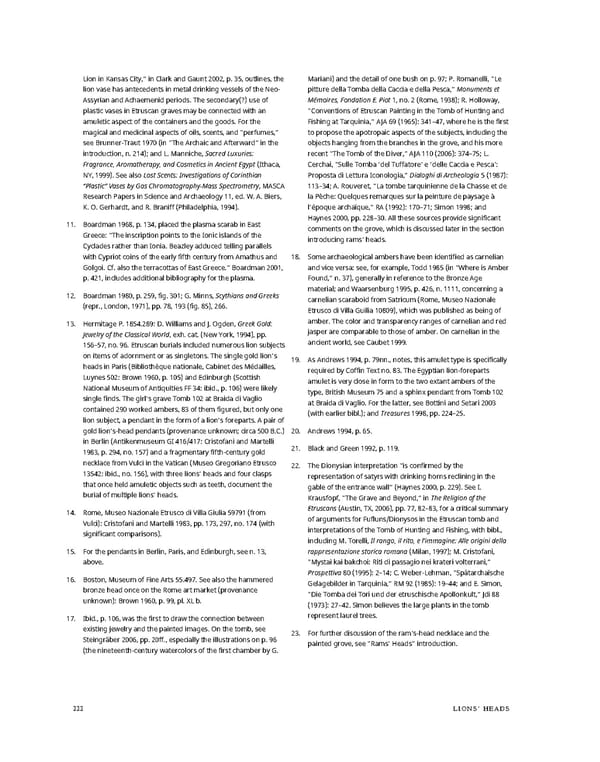Lion in Kansas City,” in Clark and Gaunt 2002, p. 35, outlines, the Mariani) and the detail of one bush on p. 97; P. Romanelli, “Le lion vase has antecedents in metal drinking vessels of the Neo- pitture della Tomba della Caccia e della Pesca,” Monuments et Assyrian and Achaemenid periods. The secondary(?) use of Mémoires, Fondation E. Piot 1, no. 2 (Rome, 1938); R. Holloway, plastic vases in Etruscan graves may be connected with an “Conventions of Etruscan Painting in the Tomb of Hunting and amuletic aspect of the containers and the goods. For the Fishing at Tarquinia,” AJA 69 (1965): 341–47, where he is the first magical and medicinal aspects of oils, scents, and “perfumes,” to propose the apotropaic aspects of the subjects, including the see Brunner-Traut 1970 (in “The Archaic and Afterward” in the objects hanging from the branches in the grove, and his more introduction, n. 214); and L. Manniche, Sacred Luxuries: recent “The Tomb of the Diver,” AJA 110 (2006): 374–75; L. Fragrance, Aromatherapy, and Cosmetics in Ancient Egypt (Ithaca, Cerchai, “Sulle Tomba ‘del Tuffatore’ e ‘delle Caccia e Pesca’: NY, 1999). See also Lost Scents: Investigations of Corinthian Proposta di Lettura Iconologia,” Dialoghi di Archeologia 5 (1987): “Plastic” Vases by Gas Chromatography-Mass Spectrometry, MASCA 113–34; A. Rouveret, “La tombe tarquinienne de la Chasse et de Research Papers in Science and Archaeology 11, ed. W. A. Biers, la Pêche: Quelques remarques sur la peinture de paysage à K. O. Gerhardt, and R. Braniff (Philadelphia, 1994). l’époque archaïque,” RA (1992): 170–71; Simon 1998; and 11. Boardman 1968, p. 134, placed the plasma scarab in East Haynes 2000, pp. 228–30. All these sources provide significant Greece: “The inscription points to the Ionic islands of the comments on the grove, which is discussed later in the section Cyclades rather than Ionia. Beazley adduced telling parallels introducing rams’ heads. with Cypriot coins of the early fifth century from Amathus and 18. Some archaeological ambers have been identified as carnelian Golgoi. Cf. also the terracottas of East Greece.” Boardman 2001, and vice versa: see, for example, Todd 1985 (in “Where is Amber p. 421, includes additional bibliography for the plasma. Found,”n. 37), generally in reference to the Bronze Age 12. Boardman 1980, p. 259, fig. 301; G. Minns, Scythians and Greeks material; and Waarsenburg 1995, p. 426, n. 1111, concerning a (repr., London, 1971), pp. 78, 193 (fig. 85), 266. carnelian scaraboid from Satricum (Rome, Museo Nazionale Etrusco di Villa Guilia 10809), which was published as being of 13. Hermitage P. 1854.289: D. Williams and J. Ogden, Greek Gold: amber. The color and transparency ranges of carnelian and red Jewelry of the Classical World, exh. cat. (New York, 1994), pp. jasper are comparable to those of amber. On carnelian in the 156–57, no. 96. Etruscan burials included numerous lion subjects ancient world, see Caubet 1999. on items of adornment or as singletons. The single gold lion’s 19. AsAndrews 1994, p. 79nn., notes, this amulet type is specifically heads in Paris (Bibliothèque nationale, Cabinet des Médailles, required by Coffin Text no. 83. The Egyptian lion-foreparts Luynes 502: Brown 1960, p. 105) and Edinburgh (Scottish amulet is very close in form to the two extant ambers of the National Museum of Antiquities FF 34: ibid., p. 106) were likely type, British Museum 75 and a sphinx pendant from Tomb 102 single finds. The girl’s grave Tomb 102 at Braida di Vaglio at Braida di Vaglio. For the latter, see Bottini and Setari 2003 contained 290 worked ambers, 83 of them figured, but only one (with earlier bibl.); and Treasures 1998, pp. 224–25. lion subject, a pendant in the form of a lion’s foreparts. A pair of gold lion’s-head pendants (provenance unknown; circa 500 B.C.) 20. Andrews 1994, p. 65. in Berlin (Antikenmuseum GI 416/417: Cristofani and Martelli 21. Black and Green 1992, p. 119. 1983, p. 294, no. 157) and a fragmentary fifth-century gold necklace from Vulci in the Vatican (Museo Gregoriano Etrusco 22. The Dionysian interpretation “is confirmed by the 13542: ibid., no. 156), with three lions’ heads and four clasps representation of satyrs with drinking horns reclining in the that once held amuletic objects such as teeth, document the gable of the entrance wall” (Haynes 2000, p. 229). See I. burial of multiple lions’ heads. Krausfopf, “The Grave and Beyond,” in The Religion of the 14. Rome, Museo Nazionale Etrusco di Villa Giulia 59791 (from Etruscans (Austin, TX, 2006), pp. 77, 82–83, for a critical summary Vulci): Cristofani and Martelli 1983, pp. 173, 297, no. 174 (with of arguments for Fufluns/Dionysos in the Etruscan tomb and significant comparisons). interpretations of the Tomb of Hunting and Fishing, with bibl., including M. Torelli, Il rango, il rito, e l’immagine: Alle origini della 15. For the pendants in Berlin, Paris, and Edinburgh, see n. 13, rappresentazione storica romana (Milan, 1997); M. Cristofani, above. “Mystai kai bakchoi: Riti di passagio nei krateri volterrani,” 16. Boston, Museum of Fine Arts 55.497. See also the hammered Prospettiva 80 (1995): 2–14; C. Weber-Lehman, “Spätarchaïsche bronze head once on the Rome art market (provenance Gelagebilder in Tarquinia,” RM 92 (1985): 19–44; and E. Simon, unknown):Brown 1960, p. 99, pl. XL b. “Die Tomba dei Tori und der etruschische Apollonkult,” Jdi 88 (1973): 27–42. Simon believes the large plants in the tomb 17. Ibid., p. 106, was the first to draw the connection between represent laurel trees. existing jewelry and the painted images. On the tomb, see 23. For further discussion of the ram’s-head necklace and the Steingräber 2006, pp. 20ff., especially the illustrations on p. 96 painted grove, see “Rams’ Heads” introduction. (the nineteenth-century watercolors of the first chamber by G. 222 LIONS’ HEADS
 Ancient Carved Ambers in the J. Paul Getty Museum Page 231 Page 233
Ancient Carved Ambers in the J. Paul Getty Museum Page 231 Page 233